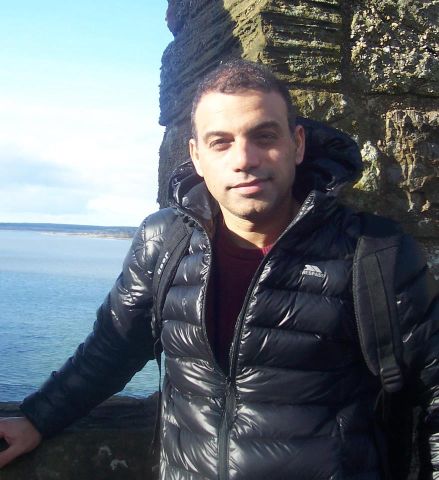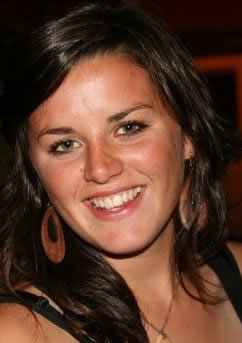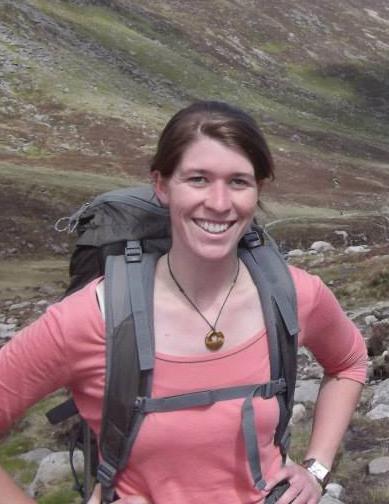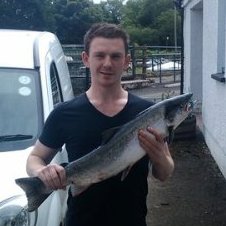
Shelf Sea Modelling Research Group
Group members
More information ...
Dr Simon Neill
 I am a lecturer in shelf sea modelling and marine renewable energy at the School of Ocean Sciences, Bangor University. I was awarded a BEng in Civil Engineering from the University of Dundee (1997), and a PhD in estuarine dynamics from the University of Strathclyde (2002). I have been at the School of Ocean Sciences since 2001 where I initially worked as a postdoc on various applied modelling projects with Prof. Alan Elliott. I was appointed to my present post in December 2006.
I am a lecturer in shelf sea modelling and marine renewable energy at the School of Ocean Sciences, Bangor University. I was awarded a BEng in Civil Engineering from the University of Dundee (1997), and a PhD in estuarine dynamics from the University of Strathclyde (2002). I have been at the School of Ocean Sciences since 2001 where I initially worked as a postdoc on various applied modelling projects with Prof. Alan Elliott. I was appointed to my present post in December 2006.
I investigate a wide range of oceanographic processes at a variety of spatial and temporal scales. My research methods are a combination of numerical models and ship-based observations, and I would estimate the ratio as around 70:30 in favour of modelling. My main area of research these days tends to be marine renewable energy. I quantify the wave and tidal resource over a range of (spatial and temporal) scales, and simulate the environmental impact of extracting energy from the oceans. I couple oceanographic models with atmospheric forcing, and apply much of my modelling to the study of sediment dynamics and morphodynamics. I also simulate how shelf sea processes have varied over the recent geological past, and how inter-annual and inter-seasonal variability in the climate affects the dispersal and large-scale connectivity of marine organisms.
Visit Dr Simon Neill's staff page.
Dr M. Reza Hashemi
 I am a research fellow at the Centre for Applied Marine Science (CAMS), the commercial arm of the School of Ocean Sciences. I was awarded BEng (1997) and MSc (1999) in Civil Engineering from Shiraz University. My PhD (2006) concerned numerical modelling of the free surface flow and shallow water equations using Differential Quadrature Method.
I am a research fellow at the Centre for Applied Marine Science (CAMS), the commercial arm of the School of Ocean Sciences. I was awarded BEng (1997) and MSc (1999) in Civil Engineering from Shiraz University. My PhD (2006) concerned numerical modelling of the free surface flow and shallow water equations using Differential Quadrature Method.
I am interested in the mathematical and numerical modelling of shelf sea hydrodynamics and sediment transport. In my academic research, I apply new and powerful numerical techniques such as Differential Quadrature, Radial Basis Function Based Meshless methods, and Smoothed Particle Hydrodynamics (SPH). My applied research areas mainly concern marine renewable energy (resource assessment and environmental impacts), climate change modelling, and shelf sea morphodynamics using well known open source numerical codes. I am familiar with TELEMAC, TOMAWAC, SWAN and ROMS, and, more specifically, model coupling in order to understand wave-current-sediment interactions. I have occasionally used black box models like artificial neural networks (ANN) to model very complicated processes.
Dr Peter Robins
After gaining a degree in Physical Oceanography and Mathematics at Bangor University (BU) in 2003, I completed my PhD (also at BU) in 2008, titled ‘Baroclinic Circulation in the Gareloch: A Scottish Fjord’. I have continued ocean modelling research at BU and am currently a Research Fellow at the Centre for Applied Marine Sciences. Over the past 10 years, my interests have encapsulated a variety of modelling methods, mainly based around different models of the European shelf seas, and the Irish Sea in particular.
Since my doctoral studies, I have continued to model baroclinic circulation, working closely with marine biologists and geneticists to investigate biophysical larval dispersal modelling. This multidisciplinary approach allows us to better understand marine population dynamics and ecological processes. Another key area of interest has been morphodynamic modelling of Welsh estuaries and coasts. High resolution, finite-element morphodynamic models have been developed to simulate estuarine processes, sediment transport, flood risk and coastal management. Additionally, I have been investigating the hydrodynamic resource of the Irish Sea, for the purpose of tidal-stream energy extraction. Potential impacts arising from such exploitation, for example changes to sediment transport and distribution, are being studied in relation to natural variability.
Dr Matt Lewis
My connection with Bangor University began as an undergraduate in Marine Biology/Oceanography. Later I studied here as an MSc student in Applied Physical Oceanography, where I made direct observations of internal waves with Prof. John Simpson. Afterwards, I worked as a modelling technician for NIWA, where I helped develop computational grids (such as the RiCOM computational grid for tidal prediction around New Zealand), as well as running numerous regional 2D and 3D hydrodynamic models, including Lagrangian particle tracking simulations of larval dispersal. My subsequent PhD studies, at Bristol University and the National Oceanographic Centre (Liverpool), investigated the uncertainties within modelling future coastal flood risk; such as the difficulties within coupling future climate predictions from Regional Circulation Models, shelf sea hydrodynamic models, and local-scale inundation models. During my PhD research, I developed methodologies for quantifying the uncertainties arising from temporal and spatial scales that are not resolved within these storm tide inundation models of future flood risk assessment. Here at Bangor University, I am now interested in characterising the natural climate variability within shelf sea models of SWAN and ROMS, as well as cascading this information into local scale models such as UNIBEST-TC.
Sophie Ward (PhD student)
 I am undertaking a PhD in Physical Oceanography, having graduated from the MSc in Applied Physical Oceanography, also at Bangor University, in 2010. My first degree was a BSc Hons in Natural Sciences at the University of Bath, where my major subjects were Physics and Environmental Sciences.
I am undertaking a PhD in Physical Oceanography, having graduated from the MSc in Applied Physical Oceanography, also at Bangor University, in 2010. My first degree was a BSc Hons in Natural Sciences at the University of Bath, where my major subjects were Physics and Environmental Sciences.
My PhD is a palaeo-study of the period since the Last Glacial Maximum (LGM, ca. 21 kyr BP), which focuses on the impact of the evolving tides and hydrodynamics over the northwest European shelf seas on large-scale sediment dynamics. ROMS is being used to simulate the tidal conditions during past sea levels, with palaeotidal model outputs from POLCOMS and KUTM available for comparison. I also have experience using KUTM during my MSc studies, and more recently I have been using the atmospheric model WRF to attempt to improve on existing palaeowind datasets and simulate palaeo wave climates. My research interests include tidal modelling, palaeoceanography, sediment transport, and marine renewables.
Alice Goward Brown (PhD student)

Juan Jesus Gomiz Pascual (PhD student)
 I am a PhD student at the School of Ocean Sciences, specialising in numerical modelling and operational oceanography. I completed a BSc in Marine Science (main subject: Oceanography) at the University of Cádiz, Spain (2001-2006) and a Masters in Oceanology, main subject: Physical Oceanography (2007-2008). After my studies, I worked in the department of Applied Physics at the University of Cádiz on various topics (effect of internal waves on vertical mixing processes of the Alboran Sea, 2D and 3D modelling of internal waves in the Straight of Gibraltar, involved in many sea going expeditions, responsible for the design of mooring lines and data collection). In March 2013, I began my PhD studies at Bangor University.
I am a PhD student at the School of Ocean Sciences, specialising in numerical modelling and operational oceanography. I completed a BSc in Marine Science (main subject: Oceanography) at the University of Cádiz, Spain (2001-2006) and a Masters in Oceanology, main subject: Physical Oceanography (2007-2008). After my studies, I worked in the department of Applied Physics at the University of Cádiz on various topics (effect of internal waves on vertical mixing processes of the Alboran Sea, 2D and 3D modelling of internal waves in the Straight of Gibraltar, involved in many sea going expeditions, responsible for the design of mooring lines and data collection). In March 2013, I began my PhD studies at Bangor University.
My PhD project is funded by Fujitsu and HPC Wales.
The title of my PhD is “Simulating the impacts of climate change on estuarine dynamics using an integrated catchment-to-coast model”, and my supervisors are Dr Reza Hashemi, Dr Peter Robins, Dr Simon Neill and Prof. Colin Jago.
The objective of the project is to develop an integrated model of an estuary (from catchment to coast) to predict the responses of the negative impacts of climate change on estuaries which can severely affect the natural environment and those communities who live there.
I am working with hydrological models (TELEMAC, DELFT 3D) and with catchment models (SWAT, PDM) to develop this work initially in the Dyfi Estuary, and then to apply the methodology to contrasting estuarine systems.
Ben Edwards (MSc student)
 I am a masters student studying Physical Oceanography at Bangor University, with a BSc in Oceanography and Computing, also from Bangor. I concentrate mostly on tides, with my masters project modelling tidal stream arrays using the Gerris flow solver. The aim of the project is to optimise the configuration of a tidal stream array.
I am a masters student studying Physical Oceanography at Bangor University, with a BSc in Oceanography and Computing, also from Bangor. I concentrate mostly on tides, with my masters project modelling tidal stream arrays using the Gerris flow solver. The aim of the project is to optimise the configuration of a tidal stream array.
Emma Slater (MSc student)
 My background includes a degree in Oceanography and Computing from Bangor University, and I am currently studying for a masters in Physical Oceanography. Using HPC Wales, I am using the 3rd generation spectral wave model (SWAN) to determine the wave resource and environmental impacts of a proposed wave energy converter (WEC) array in Orkney.
My background includes a degree in Oceanography and Computing from Bangor University, and I am currently studying for a masters in Physical Oceanography. Using HPC Wales, I am using the 3rd generation spectral wave model (SWAN) to determine the wave resource and environmental impacts of a proposed wave energy converter (WEC) array in Orkney.
Kris Calder (MSc student)
 I am a Masters student studying Physical Oceanography at Bangor University with a background in Marine Biology and a keen interest in computer modelling. Specifically, my thesis investigates flows past Tidal Energy Convertor (TEC) arrays and the resulting wake structures generated by devices within the array. This is achieved using HPC Wales to run 2D and 3D simulations using the Gerris flow solver. Furthermore, Gerris shall be used to model bounded and unbounded flows past turbines to replicate TEC arrays that are placed in tidal channels and open oceans respectively. The ultimate aim of my project is to optimise the spacing between the devices within a TEC array in order to maximise energy yield whilst minimising hydro-environmental impacts.
I am a Masters student studying Physical Oceanography at Bangor University with a background in Marine Biology and a keen interest in computer modelling. Specifically, my thesis investigates flows past Tidal Energy Convertor (TEC) arrays and the resulting wake structures generated by devices within the array. This is achieved using HPC Wales to run 2D and 3D simulations using the Gerris flow solver. Furthermore, Gerris shall be used to model bounded and unbounded flows past turbines to replicate TEC arrays that are placed in tidal channels and open oceans respectively. The ultimate aim of my project is to optimise the spacing between the devices within a TEC array in order to maximise energy yield whilst minimising hydro-environmental impacts.

